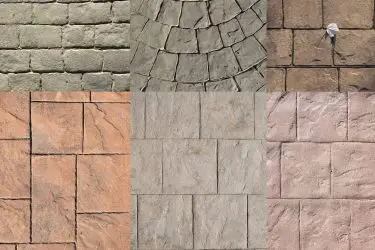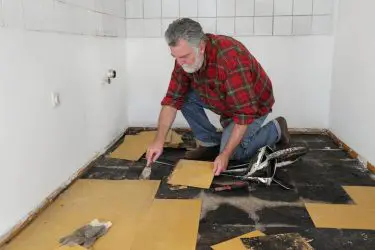Did you know that when concrete mortar is subjected to increased temperatures, there is a decrease in compressive and tensile strengths? With that in mind, finding suitable material is vital for beginners and DIYers trying to save a little on renovations. So, what concrete should you use for a fireplace?
Concrete to use for a fireplace includes a mix of high alumina cement and refractory aggregates, such as crushed bricks, limestone, or slag. Before being subjected to high heat, allow it to dry and cure for several days, and always be sure that the firebox is reinforced with brick or metal.
This article will detail more about high alumina cement and refractory aggregates, which are ideal for a fireplace. We’ll also cover the properties of concrete when exposed to high temperatures and some of the pros and cons of making a fireplace with these materials.

Table of Contents
What Concrete Should You Use for a Fireplace?
You should use concrete such as Rutland Castable Refractory Cement for a fireplace to protect the surface from extreme temperatures. Aggregates will include sand, and high alumina cement (HAC), which is made up of calcium aluminates. Its strength is ideal for areas exposed to high heat.
Concrete is often considered for fireplaces due to its durability and ability to resist fire. Mixing concrete for your fireplace is relatively simple, and there is an abundance of information online to help you get started.
Still, there is a right and wrong way to approach this, as concrete changes slightly when exposed to heat (which we’ll cover below).
High Alumina Cement
High alumina cement (aka calcium aluminum cement) is created by grinding certain materials, such as lime and chalk. This gets ground and heated before being cooled and ground again.
Though it was first used in sewers and underwater construction, it is often utilized in chimneys and furnaces due to its high heat resistance.
As it is very fine, it is essential to wear a mask and safety goggles when handling.
Refractory Cement
Refractory cement is, simply put, cement enhanced with heat-resistant properties, such as refractory aggregates. They usually come premixed and packaged for easier use by the consumer.
Also known as “heat-resistant concrete,” its primary additive is high alumina cement, and there are two main types two consider:
- High-grade heat-resistant concrete is used in areas of extreme heat, such as the hot face of a kiln.
- Low-grade heat-resistant concrete is used in areas of lesser heat.
Concrete With High Alumina Cement and Refractory Aggregates
As mentioned above, to make your fireplace strong and durable, the materials you require include sand, crushed bricks, and HAC, such as the Rutland Castable Refractory Cement from Amazon.com.

Though regular cement and mortar would be ok for fillers, or even around some of the edges, it’s vital to get something extra-strong for the firebox. In most cases, the firebox is constructed out of brick or metal to ensure its durability. Behind this, and around, you still need the added security of using concrete with refractory aggregates.
Can Concrete Explode In a Fireplace?
Concrete can explode when exposed to extremely high heat. In a recent study by Empa, a concrete slab was heated up to about 600ºC (1,112ºF), and it exploded due to a severe loss of strength. As most fires will reach such temperatures, it’s critical to reinforce the materials for added safety.
Concrete is made of sand, cement, and water, and it is reinforced during major construction projects, such as skyscrapers and bridges, to enhance its performance.
Unfortunately, a study in the Cement and Concrete Research Journal revealed that concrete explodes due to the properties that also make it strong: having very few pores.
These few pores do not allow moisture and steam to move out, building up concrete pressure freely. This increase in pressure causes parts of the concrete to blow away in what some would call an explosion.
How to Safeguard Your Fireplace from Extreme Heat
Heat-resistant refractory concrete can survive extreme temperatures and may be used for hot-face applications, just as its name suggests. A hot-face application is one whose surface is in contact with the main source of heat.

I suggest buying heat-resistant cement-like Meeco’s Red Devil Furnace Cement from Amazon.com to mix with your concrete to assure you of a durable and robust fireplace. This specific product will protect your fireplace up to 2,000°F (1093.33°C), which is much higher than the average fire burns.
Properties of Concrete at High Temperatures
Temperatures above 300ºC (572ºF) degrade the mechanical properties of concrete. These properties are responsible for the durability and reliability of concrete used at a fireplace, and include:
- Compressive strength
- Tensile strength
- Stiffness
- Spalling
Let’s take a closer look at each below.
Compressive Strength
Compressive strength in concrete refers to the amount of weight or pressure concrete can hold. To put that into context, it is measured by “pressing together” the concrete, mostly by adding a heavy weight on top.
The compressive strength of concrete decreases with an increase in temperature. At higher heat, concrete loses its moisture content due to evaporation, meaning the mixture proportions and type of aggregates influence the reduction in strength of heated concrete.
Lean concrete (liquid and pourable) with low cement content has a smaller reduction in compressive strength due to the amount of water used. However, when the compressive forces holding the concrete together decreases, it becomes prone to cracks and even explosions.
Tensile Strength
The tensile strength of concrete refers to its ability to resist cracking under tension. Unlike compressive strength which measures concrete’s strength when “pressed together,” tensile strength measures the strength when “pulled apart.”
However, just like concrete’s compressive strength, its tensile strength also decreases with an increase in temperatures.
Stiffness
The stiffness of concrete is often constant at low levels of stress. However, it decreases with an increase in temperature and higher stress levels.
Concrete features a low coefficient of thermal expansivity, which is the tendency of matter to alter its shape, volume, or area in response to temperature changes. Concrete should be made in such a way that provisions for expansion are made to prevent cracking.
Spalling
Spalling is often seen in steel-reinforced concrete. Defined as small particles of material flaking away from the main body, spalling usually happens when the steel rebars become rusty.
When concrete is heated rapidly and the steam created from the moisture inside cannot escape fast enough, pressure begins to form under the surface. As the pressure builds, spalling will occur, and it can become very dangerous.
As with each of these properties, spalling is more prone to occur at high temperatures, though this may be the one to look out for in a fireplace, as it is unlikely the area will be “pressed” or “pulled.” Instead, you’re more likely to see issues with moisture and pressure from within.
Pros of Concrete Fireplaces
Over the years, concrete has become a popular material for fireplaces, countertops, roofing, floors, and sinks. It is incredibly versatile and one of the DIYer’s first options when it comes to making fireplaces.
The main advantages of using concrete for fireplaces are:
- It is durable and long-lasting if well maintained.
- It can increase your home’s value when used with intricate designs.
- It can enhance your home’s heating efficiency because the block absorbs and then redistributes any heat produced.
Cons of Concrete Fireplaces
As popular as they may be, we’ve already established that under the wrong circumstances, concrete fireplaces can be dangerous. When not done by professionals, it’s more likely that something can go wrong, as many DIYers opt for cheaper materials, and don’t always know the right methods to ensure safety.
Here are a few other drawbacks of concrete fireplaces:
- Concrete fireplaces are difficult and expensive to install because they require a foundation and are often heavy.
- They take up a lot of space in a room because they necessitate clearance from combustible materials.
- They are not environmentally friendly.
Maintaining A Concrete Fireplace
Even the best fireplaces can crack and look bad if neglected. To ensure your home’s safety, your fireplace and chimneys should be inspected at least once every year. These inspections will look that you have the correct clearances, that the structure is sound, and that it is free from deposits.
The good news is that maintaining your fireplace is easy. Here are some simple steps:
- Make sure you use suitable wood.
- Install smoke and carbon monoxide alarms.
- Remember to clear any creosote and soot build-up.
Fortunately, concrete fireplaces only require a low-maintenance budget and are durable.
Final Thoughts
Concrete, when chosen with consideration to design, can be used to decorate both indoors and outdoors. It is versatile and a popular choice, precisely due to its durability.
Provided you take the necessary measures and reinforce your concrete with high alumina cement and refractory aggregates, you should be able to create a beautiful, safe, and conversation-inspiring fireplace.



